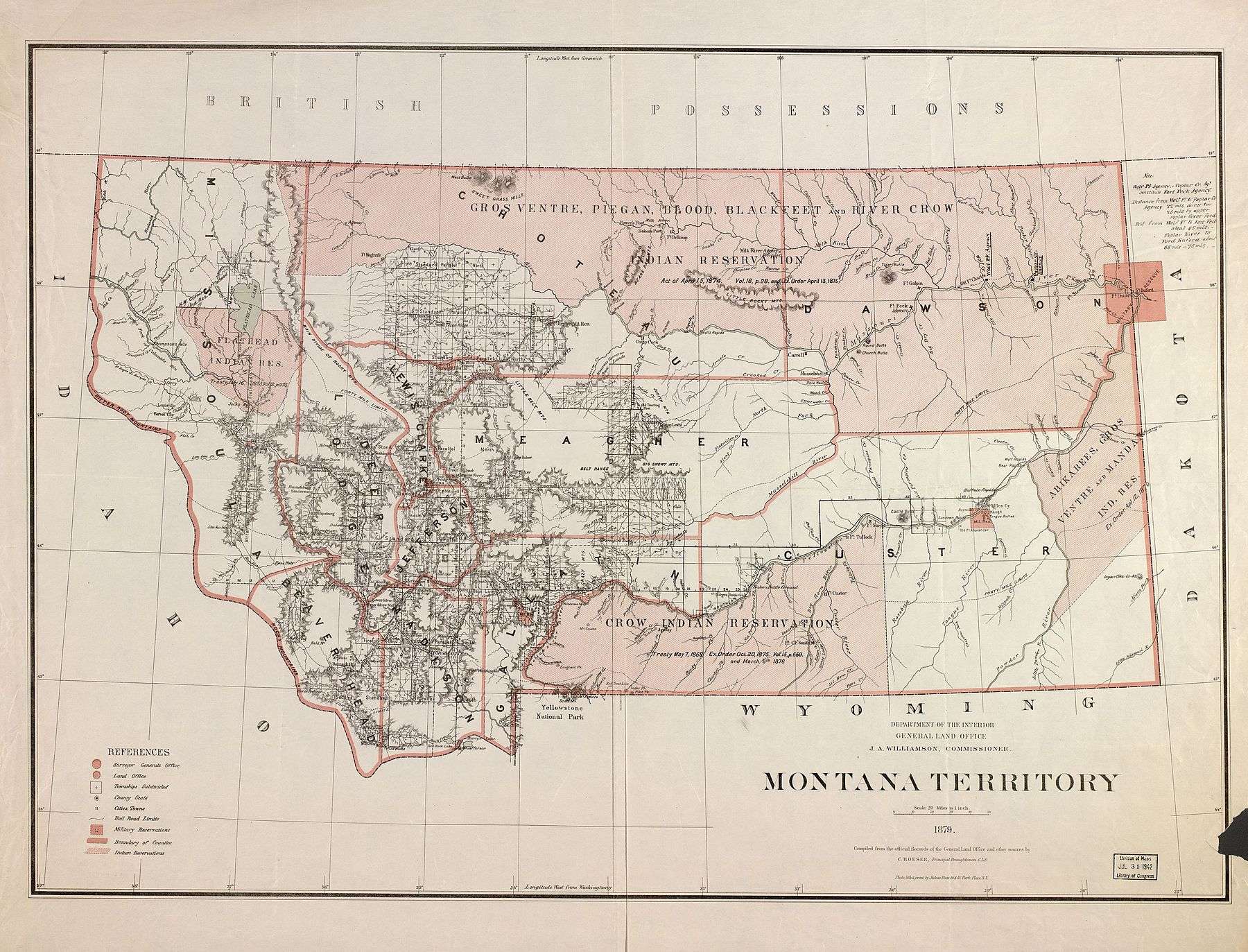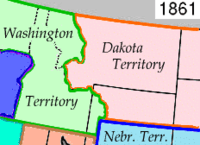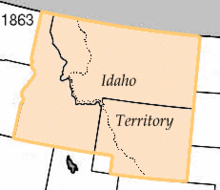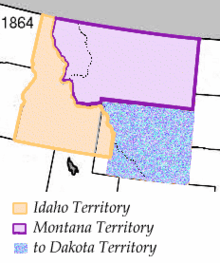Montana Territory
| Territory of Montana | |||||
| Organized incorporated territory of the United States | |||||
| |||||
|
Coat of arms | |||||
 | |||||
| Capital | Bannack (May 28, 1864-February 6, 1865) Virginia City (February 7, 1865-1875) Helena (1875–1889) | ||||
| Government | Organized incorporated territory | ||||
| History | |||||
| • | Split from Idaho Territory | May 26, 1864 | |||
| • | Statehood | November 8, 1889 | |||
The Territory of Montana was an organized incorporated territory of the United States that existed from May 26, 1864, until November 8, 1889, when it was admitted as the 41st state in the Union as the State of Montana.
Original boundaries
The Montana Territory was organized out of the existing Idaho Territory by Act of Congress and signed into law by President Abraham Lincoln on May 26, 1864. The areas east of the Continental Divide had been previously part of the Nebraska Territory and Dakota Territory and had been acquired by the United States in the Louisiana Purchase.
The territory also included a portion of the Idaho Territory west of the continental divide and east of the Bitterroot Range, which had been acquired by the United States in the Oregon Treaty, and originally included in the Oregon Territory. The part of the Oregon Territory that became part of Montana had been split off as part of the Washington Territory.
The boundary between the Washington Territory and Dakota Territory was the Continental Divide (as shown on the 1861 map); however, the boundary between the Idaho Territory and the Montana Territory followed the Bitterroot Range north of 46°30′ north (as shown on the 1864 map). This change was due in part to Congress unifying the area with the creation of Idaho Territory in 1863, coupled with the subsequent political maneuvering of Sidney Edgerton, soon to be the first Territorial Governor of Montana, and his allies in the Congress. They successfully implemented the boundary change that won the Flathead and Bitterroot valleys for Montana Territory.[1] The Organic Act of the Territory of Montana[2] defines the boundary as extending from the modern intersection of Montana, Idaho, and Wyoming at:
The forty-fourth degree and thirty minutes of north latitude; thence due west along said forty-fourth degree and thirty minutes of north latitude to a point formed by its intersection with the crest of the Rocky Mountains; thence following the crest of the Rocky Mountains northward till its intersection with the Bitter Root Mountains; thence northward along the crest of the Bitter Root Mountains to its intersection with the thirty-ninth degree of longitude west from Washington; thence along said thirty-ninth degree of longitude northward to the boundary line of British possessions.
The boundaries of the territory did not change during its existence. It was admitted to the Union as the State of Montana on November 8, 1889.



- de Lacy's 1865 map of Montana Territory
 de Lacy's 1872 map of Montana Territory
de Lacy's 1872 map of Montana Territory
Government
The act of Congress of 1864 creating Montana, known as the Organic Act,[3] prescribed a somewhat standard organization for the territorial government of Montana. It established executive, judicial, and legislative branches of government, however, the federal government held a dominant role in administering the new territory. Particularly, the Congress reserved the right to nullify any laws passed by the citizen-elected territorial legislature. The President of the United States appointed the most powerful positions in the territory, including a governor, secretary of the territory, and three members of the territorial supreme court, with the advice and consent of the U.S. Senate. The citizens of the territory elected a legislative assembly, consisting of a Council and House of Representatives, which together created the laws for the territory. Citizens also elected a lone delegate to Congress as strictly an advisor to the U.S. House of Representatives; a territorial delegate was not permitted to vote.[4] The territorial government was meant to provide a training ground for a future move to statehood, allowing time for an area's institutions to mature and populations to grow.[5]
Executive
Governor
The governor served a four-year term, unless removed by the President. Duties of the office included 1) the faithful execution of the laws, 2) to serve as the commander-in-chief of the militia, and 3) to serve as the superintendent of Indian affairs. The governor also had to approve or veto laws within three days of passage by the territorial legislative assembly.[6]
- Parties
Dem Democratic Rep Republican
| # | Governor | Party | Term start | Term end | Appointed by | Notes |
|---|---|---|---|---|---|---|
| 1 | Edgerton, SidneySidney Edgerton | Rep | June 22, 1864 | July 12, 1866 | Lincoln, AbrahamAbraham Lincoln | Did not find out he had been appointed right away; left the state in September 1865 and did not return for 25 years |
| 2 | Smith, Green ClayGreen Clay Smith | Dem | July 13, 1866 | April 9, 1869 | Johnson, AndrewAndrew Johnson | Did not assume office until October 1866; stopped functioning as governor in summer 1868 |
| 3 | Ashley, James MitchellJames Mitchell Ashley | Rep | April 9, 1869 | July 12, 1870 | Grant, Ulysses S.Ulysses S. Grant | Removed from office by President Ulysses S. Grant in mid-December 1869 for unclear reasons.[8] |
| 4 | Potts, Benjamin F.Benjamin F. Potts | Rep | July 13, 1870 | January 14, 1883 | Grant, Ulysses S.Ulysses S. Grant | |
| 5 | Crosby, John SchuylerJohn Schuyler Crosby | Rep | January 15, 1883 | December 15, 1884 | Arthur, Chester A.Chester A. Arthur | |
| 6 | Carpenter, B. PlattB. Platt Carpenter | Rep | December 16, 1884 | July 13, 1885 | Arthur, Chester A.Chester A. Arthur | |
| 7 | Hauser, Samuel ThomasSamuel Thomas Hauser | Dem | July 14, 1885 | February 7, 1887 | Cleveland, GroverGrover Cleveland | |
| 8 | Leslie, Preston HopkinsPreston Hopkins Leslie | Dem | February 8, 1887 | April 8, 1889 | Cleveland, GroverGrover Cleveland | |
| 9 | White, Benjamin F.Benjamin F. White | Rep | April 9, 1889 | November 8, 1889 | Harrison, BenjaminBenjamin Harrison |
Secretary of the territory
The secretary of the territory served a four-year term, unless removed by the President. Duties of the office included 1) the recording of all laws and proceedings of the legislative assembly and the acts of the governor, 2) the transmission of copies of the laws and journals of the legislative assembly to the President and the leaders of Congress, and 3) the transmission of executive proceedings and correspondence twice a year to the President. Importantly, the secretary also served as acting governor in case of the death, removal, resignation, or absence of the governor from the territory.
- Parties
Dem Democratic Rep Republican
| # | Secretary | Party | Commissioned | Appointed by | Notes |
|---|---|---|---|---|---|
| 1 | Torsey, Henry P.Henry P. Torsey | Rep | June 22, 1864 | Lincoln, AbrahamAbraham Lincoln | Declined appointment due to poor health.[11] |
| 2 | Coburn, JohnJohn Coburn | Rep | March 3, 1865 | Lincoln, AbrahamAbraham Lincoln | Did not assume office as he resigned almost immediately upon being appointed; later in 1884 appointed a justice to the Supreme Court of Montana Territory |
| 3 | Meagher, Thomas FrancisThomas Francis Meagher | Dem | August 4, 1865 | Johnson, AndrewAndrew Johnson | He served as acting governor from Sep. 1865, when Gov. Edgerton left the territory, until Oct. 1866, when Gov. Smith arrived.[12] He served again as acting governor from early 1867, when Gov. Smith went to Washington D.C., until Meagher's death on July 1, 1867.[13] |
| 4 | Tufts, JamesJames Tufts | Rep | March 28, 1867 | Johnson, AndrewAndrew Johnson | He served as acting governor from the summer of 1868, when Gov. Smith left the territory, until the summer of 1869 when his replacement arrived.[14] |
| 5 | Scribner, Wiley S.Wiley S. Scribner | Rep | April 20, 1869 | Grant, Ulysses S.Ulysses S. Grant | He served as acting governor from mid-December 1869, when Ashley was removed, until the end of August 1870, when Gov. Potts arrived in Virginia City.[15] |
| 6 | Sanders, Addison HiattAddison Hiatt Sanders | Rep | July 19, 1870 | Grant, Ulysses S.Ulysses S. Grant | Withdrew before taking office since he took another appointment as register of the Land Office in Montana.[16] |
| 7 | Callaway, James E.James E. Callaway | Rep | January 27, 1871 | Grant, Ulysses S.Ulysses S. Grant | He did not arrive in Montana until mid-April 1871 to take up his duties;[17] he was the longest serving secretary of the territory. |
| 8 | Mills, James HamiltonJames Hamilton Mills | Rep | May 10, 1877 | Hayes, Rutherford B.Rutherford B. Hayes | |
| 9 | McCutcheon, Isaac D.Isaac D. McCutcheon | Rep | May 28, 1882 | Arthur, Chester A.Chester A. Arthur | date is given as the date he arrived in Helena; he resigned under scandal in Sep. 1883[18] |
| 10 | Tooker, John S.John S. Tooker | Rep | 1883 | Arthur, Chester A.Chester A. Arthur | He appears to have been commissioned sometime during the last three months of 1883 after McCutcheon's resignation,[19][20] though one source reports him being appointed in Jan. 1884,[21] and another on April 21, 1884.[22] |
| 11 | Webb, William B.William B. Webb | Dem | October 23, 1885 | Cleveland, GroverGrover Cleveland | One source has Webb appointed in 1886.[23] |
| 12 | Walker, Louis A.Louis A. Walker | Rep | April 15, 1889 | Harrison, BenjaminBenjamin Harrison |
Congressional delegation
The eligible citizens of Montana Territory voted for a delegate to Congress, electing them to a two-year term. The territorial delegate had a seat in the House of Representatives and, as any other representative, participated in debates, yet they did not have the right to vote.[24] During the time Montana was a territory, some delegates to Congress were allowed to sit on select committees and even standing committees of the House, yet as on the floor of the House, they were not permitted to vote.[25]
- Parties
Dem Democratic Rep Republican
| # | Delegate | Party | Term start | Term end | Congress | Notes |
|---|---|---|---|---|---|---|
| 1 | McLean, SamuelSamuel McLean | Dem | January 6, 1865 | March 3, 1867 | 38th, 39th | |
| 2 | Cavanaugh, James M.James M. Cavanaugh | Dem | March 4, 1867 | March 3, 1871 | 40th, 41st | |
| 3 | Clagett, William H.William H. Clagett | Rep | March 4, 1871 | March 3, 1873 | 42nd | |
| 4 | Maginnis, MartinMartin Maginnis | Dem | March 4, 1873 | March 3, 1885 | 43rd, 44th, 45th, 46th, 47th, 48th | |
| 5 | Toole, JosephJoseph Toole | Dem | March 4, 1885 | March 3, 1889 | 49th, 50th | |
| 6 | Carter, Thomas H.Thomas H. Carter | Rep | March 4, 1889 | November 8, 1889 | 51st |
See also
- Timeline of pre-statehood Montana history
- American Civil War, 1861–1865
- Governors of Montana Territory
- Historic regions of the United States
- History of Montana
- Montana Territory's at-large congressional district
- Rocky Mountains
- Territorial evolution of the United States
- Territory of France that encompassed land that would later become part of the Territory of Montana:
- Louisiane, 1682–1764 and 1803
- Territory of Spain that would later be returned to France:
- Luisiana, 1764–1803
- Territory of the United Kingdom that encompassed land that would later become part of the Territory of Montana:
- Rupert's Land, 1670–1870
- International territory that encompassed land that would later become part of the Territory of Montana:
- Oregon Country, 1818–1846
- U.S. territories that encompassed land that would later become part of the Territory of Montana:
- Louisiana Purchase, 1803–1804
- District of Louisiana, 1804–1805
- Territory of Louisiana, 1805–1812
- Territory of Missouri, 1812–1821
- Provisional Government of Oregon, 1843–1849 (extralegal)
- Territory of Oregon, 1848–1859
- Territory of Washington, 1853–1889
- Territory of Nebraska, 1854–1867
- Territory of Dakota, 1861–1889
- Territory of Idaho, 1863–1890
- U.S. state created from the Territory of Montana:
- State of Montana, 1889
- Territory of France that encompassed land that would later become part of the Territory of Montana:
- William F. Wheeler, U.S. Marshal of the Montana Territory
Notes
- ↑ Malone, Roeder, and Lang 1991, p. 95.
- ↑ An Act to provide a temporary government, 1864.
- ↑ An Act to provide a temporary government, 1864.
- ↑ Renne 1958, p. 20-23.
- ↑ Renne 1958, p. 19.
- ↑ Renne 1958, p. 20-21.
- ↑ Owings 1956, p. 62.
- ↑ Spence 1968, p. 33.
- ↑ Owings 1956, p. 62-63.
- ↑ Spence 1975, p. 234.
- ↑ Spence 1975, p. 18.
- ↑ Spence 1975, p. 34, 43.
- ↑ Spence 1975, p. 51.
- ↑ Spence 1975, p. 55.
- ↑ Spence 1975, p. 68, 75.
- ↑ Spence 1975, p. 77-78, 234.
- ↑ Spence 1975, p. 78.
- ↑ Spence 1975, p. 156.
- ↑ Spence 1975, p. 234.
- ↑ Miller 1894, p. 74.
- ↑ Leeson 1885, p. 1256.
- ↑ Owings 1956, p. 63.
- ↑ Spence 1975, p. 234.
- ↑ Palmer 2011, p. 3-4.
- ↑ Palmer 2011, p. 6-8.
- ↑ Owings 1956, p. 63.
References
- "An Act to provide a temporary Government for the Territory of Montana" (PDF). Thirty-sixth United States Congress. May 26, 1864. Archived from the original (PDF) on January 12, 2007. Retrieved 2007-01-20.
- Leeson, M. A. (1885). History of Montana, 1739-1885. Chicago: Warner, Beers & Co.
- Malone, Michael P.; Roeder,, Richard B.; Lang, William L. (1991). Montana : a history of two centuries (Rev. ed.). Seattle: University of Washington Press. ISBN 0295971290.
- Miller, Joaquin (1894). An Illustrated History of the State of Montana. Chicago: The Lewis Publishing Co.
- Owings, Ralph E. (1956). Montana Directory of Public Affairs, 1864-1955. Ann Arbor, MI: Edwards Bothers, Inc.
- Palmer, Betsy (6 January 2011). "Delegates to the U.S. Congress: History and Current Status" (PDF). U.S. Department of State. Congressional Research Service. Retrieved 14 November 2014.
- Renne, Roland R. (1958). The Government and Administration of Montana. New York: Thomas Y. Crowell Company.
- Spence, Clark C. (Spring 1968). "Spoilsman in Montana: James M. Ashley". Montana The Magazine of Western History. Montana Historical Society. 18 (2): 24–35.
- Spence, Clark C. (1975). Territorial Politics and Government in Montana, 1864-89. Urbana, IL: University of Illinois Press.
| Wikimedia Commons has media related to Montana Territory. |
Coordinates: 46°47′N 109°22′W / 46.78°N 109.37°W
.jpg)